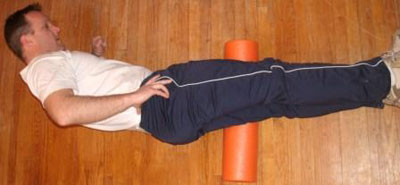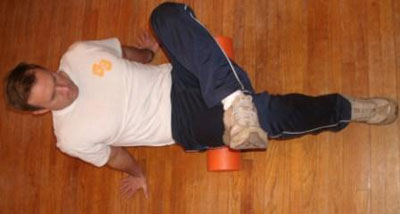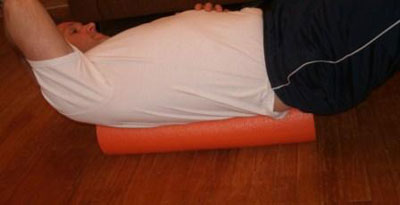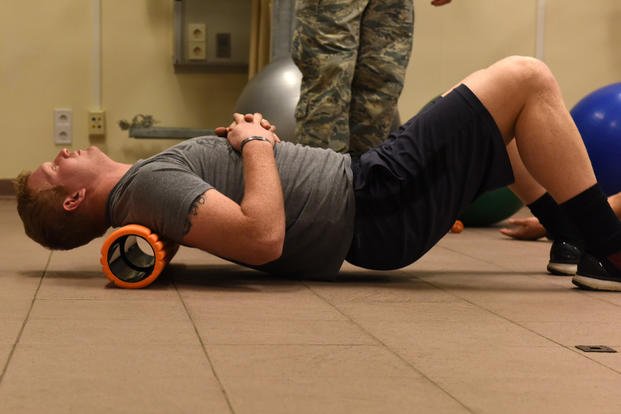Have your knees or hips ever ached at the start of a run but felt better after a short warmup jog and light stretch?
This typically is how most people start off on a run. Unfortunately, tendinitis can flare up quickly if you are running several times a week for several miles. Myofascial release (MFR) is a great way to relieve the post-exercise soreness, as well as help with a pre-exercise warmup as well. There are two ways to do MFR:
1. The foam roller: Maybe you have seen these tubes of foam in the gym and thought it was an abdominal exercise device because it does require positions that work the abs often. I use the foam roller for four main areas that cause me trouble from several workouts each week:
a. ITB (iliotibial band): Simply lie on your side, like you were performing a side plank pose, but place the foam roller under your hip. Place your body weight into the roller and move your arms to roll your body over from the hip to below your knee.
This fully "rolls out" the ITB, and it will be painful if your fascia needs loosening. I ran all summer and fall with a minor ITB syndrome without being sidelined from running, simply by rolling out my ITB daily.

b. Lower and upper back: This one just feel great Roll from your lower back all the way just below your neck to feel what I call the "poor man's masseuse." This loosens up the entire back and also will work the abs. You have to stay flexed and balanced on the roller as you move from the top to the bottom of your back. Relax and breathe as you roll.

c. Piriformis/hips: Sit on the foam roller and cross your legs. Lean slightly on the side of the crossed leg and relax into the tender spot. Roll each side for 1-2 minutes until the roll is comfortable.

d. Rhomboids and mid-back region: Place the foam roller parallel to your spine and roll back and forth across the spine and just into the upper- and lower-back muscles that run along it. Roll back and forth for 1-2 minutes and relax with deep breaths.

For more ideas in motion, go to YouTube.com and search for foam rollers or myofascial release. You will get more ideas about how to use the foam roller for other parts of the body as well. self-myofascial-release
2. The body worker: The practitioner of MFR will use their knuckles, elbows and other tools to apply pressure to fascia that needs loosening. It is quite painful during the process of breaking up the scar tissue (restricted fascia) of previous injuries, but it is remarkable how muscles, joints and soft tissue can feel after just one session. Many call this deep-tissue massage. Mysofascial-Release
The book "An Osteopathic Approach to Diagnosis and Treatment (Third ed.)" explains why and how this process works.
"Myofascial release is a form of soft tissue therapy used to treat somatic dysfunction and accompanying pain and restriction of motion. This is accomplished by relaxing contracted muscles, increasing circulation, increasing venous and lymphatic drainage, and stimulating the stretch reflex of muscles and overlying fascia."
One of the authors, Eileen DiGiovanna, continued.
"Fascia is the soft tissue component of the connective tissue that provides support and protection for most structures within the human body, including muscle. This soft tissue can become restricted due to psychogenic disease, overuse, trauma, infectious agents or inactivity, often resulting in pain, muscle tension and corresponding diminished blood flow. Although fascia and its corresponding muscle are the main targets of myofascial release, other tissue may be affected as well, including other connective tissue."
I hope this was helpful to you. If you are feeling the sting of a few nagging injuries or simple overuse injuries, give this a try. You always should visit your doctor, though, before attempting to self-treat or self-medicate.
For more information on programs that will help you pass any physical fitness test, check out the Military.com Fitness eBook store.
Stew Smith is a former Navy SEAL and fitness author certified as a Strength and Conditioning Specialist (CSCS) with the National Strength and Conditioning Association. Visit his Fitness eBook store if you’re looking to start a workout program to create a healthy lifestyle. Send your fitness questions to stew@stewsmith.com.
Want to Learn More About Military Life?
Whether you're thinking of joining the military, looking for fitness and basic training tips, or keeping up with military life and benefits, Military.com has you covered. Subscribe to Military.com to have military news, updates and resources delivered directly to your inbox.



















